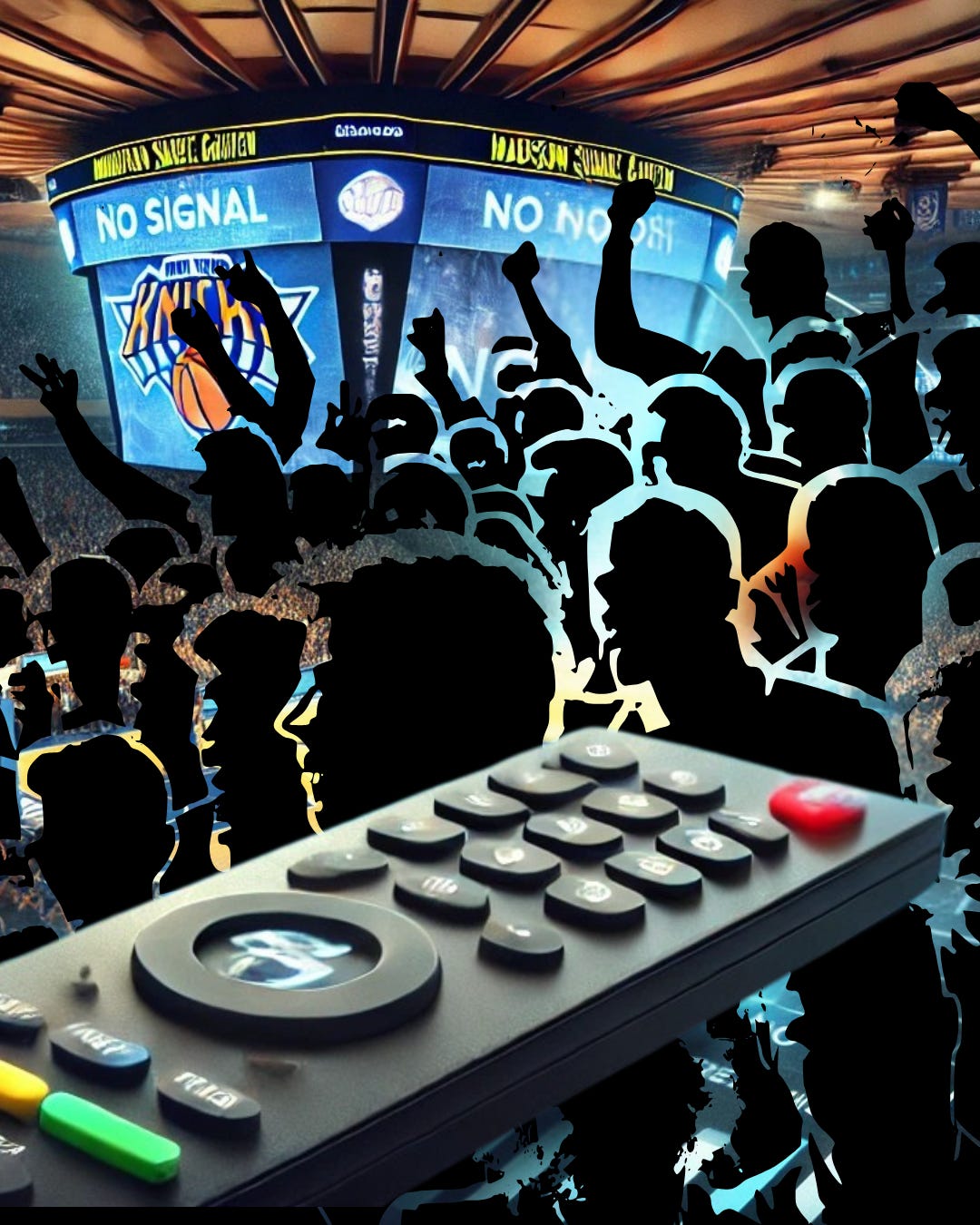The Changing Game: Cable Blackouts, Streaming, and the Future of Sports
Part 3 – The Battle to Stay Relevant
Welcome to Rupt and Rise, a space where transformation takes center stage. Here, we spotlight stories of disruption, reinvention, and resilience - proof that every rupture holds the power to rise.
In 2012, MSG Networks was fighting with Time Warner Cable over how much cable subscribers should pay to watch Knicks and Rangers games.
In 2025, MSG Networks is now fighting with Optimum, leaving over 1 million households in the dark.
In both instances, MSG Networks has relied on KeepMSG.com, a website urging fans to pressure their cable providers and contact government officials - specifically, the Attorneys General in the Tri-State area - to demand a resolution. Meanwhile, Governor Kathy Hochul has weighed in, calling on both sides to resolve the dispute.
But this time? The stakes are much bigger. MSG Networks is battling Optimum and battling for its survival.
For all the headlines about blackouts and carriage disputes, what’s really happening is the slow-motion collapse of the Regional Sports Network (RSN) model - the business structure that once made billions for networks like MSG, YES, and Bally Sports but is now crumbling under debt, shifting consumer habits, and the rise of streaming.
The End of the Regional Sports Network Era
For decades, regional sports networks (RSNs) were the gold standard for local sports broadcasting. Fans had no choice but to subscribe to cable to watch their local teams, and providers like MSG Networks cashed in by charging high fees to cable companies.
But in 2025, that system is breaking down.
Here’s why:
Cable Subscriptions Are Plummeting
Fewer people are paying for traditional cable bundles.
In 2012, over 100 million U.S. households had cable - today, that number has dropped below 70 million, and it’s still falling.
This means fewer people are paying for RSN channels like MSG Networks, putting massive pressure on their business model.
The Debt Is Unmanageable and Unimaginable
MSG Networks is sitting on $829 million in debt and defaulted on payments in October 2024.
Analysts estimate the network may be worth only $500 million, far less than what it owes.
It needs a bailout, and some reports suggest Amazon could step in - but will that even work?
Teams and Leagues Are Taking Back Control
Sports teams and leagues no longer need RSNs to reach their fans.
The NBA, MLB, and NHL have started offering direct-to-consumer streaming options like League Pass and MLB.TV.
If leagues cut out the middleman (RSNs) and go straight to streaming, what happens to networks like MSG?
MSG’s Streaming Bet: Will It Work?
MSG Networks knows the cable model is dying, so it’s trying to pivot to streaming—but its approach raises big questions.
MSG+ Streaming Service:
$29.99/month or $309.99/year for Knicks and Rangers games.
Single-game purchases for $9.99 per game.
If you want MSG+ plus the YES Network, it’s $41.99/month or $359.99/year via the Gotham Sports App.
This is a huge test for the future of local sports broadcasting.
Will fans actually pay $30+ per month for MSG+?
Can streaming replace the guaranteed revenue MSG once had from cable deals?
Will leagues eventually take full control and bypass MSG entirely?
Who Actually Wins in This Shift?
Winners
The Leagues – The NBA, NHL, and MLB are getting closer to cutting out RSNs entirely. If they control streaming directly, they control the money.
Tech Giants (Amazon, Apple, YouTube) – Streaming services like Prime Video, Apple TV, and YouTube TV are swooping in to buy up live sports rights - if they take over, networks like MSG may no longer be needed.
Some Fans… Eventually – If leagues go fully direct-to-consumer, fans could get more flexibility in how they pay for games instead of expensive cable bundles.
Losers
Regional Sports Networks (Like MSG) – Unless MSG can make streaming profitable, it may not exist in 5-10 years as teams and leagues move away from RSNs.
Casual Fans – If you’re used to watching Knicks and Rangers games as part of a cheap cable bundle, the cost to watch sports is going up. Pay-per-game and multiple subscriptions mean fans will likely spend more.
Cable Companies – As more people cancel cable, providers like Optimum and Comcast lose money. Their fights with networks like MSG aren’t just about sports - it’s about survival.
So, What Happens Next?
MSG Networks is at a crossroads.
Best Case Scenario: MSG+ succeeds, fans pay for streaming, and MSG survives as a hybrid model.
Worst Case Scenario: MSG+ fails, Amazon or another giant takes over, and MSG Networks fades into irrelevance.
Most Likely Scenario: MSG struggles along for a few more years, but the NBA, NHL, and MLB eventually take full control of their own local streaming rights, leaving no need for regional networks like MSG.
This comes down to what happens to local sports coverage when cable dies.
For decades, RSNs were the only way to watch local teams play - but that era is coming to an end.
The only question left is: Who replaces them?
💬 What do you think? Will fans actually pay for MSG+? Should leagues take full control of their own streaming rights? Or is there still a place for RSNs in the future of sports media?
🔗 Read "Squabble Up: MSG Networks, Cable Blackouts, and How History Repeats Itself" 👇
#Knicks #NBA #Rangers #AMAZON #MSGNetworks #CableWars #Streaming #NBA #NHL #SportsMedia




